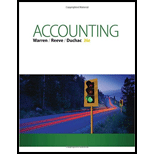
1. a)
Financial Ratios: Financial ratios are the metrics used to evaluate the liquidity, capabilities, profitability, and overall performance of a company.
Given info: Items of financial statement
The Return on total assets for five years (2012 to 2016).
1. a)
Explanation of Solution
Return on assets determines the particular company’s overall earning power. It is determined by dividing sum of net income and interest expense and average total assets.
Formula:
Return on total assets for five years (2012 to 2016) is calculated as below:
b)
The Return on stockholders’ equity for five years (2012 to 2016).
b)
Explanation of Solution
Formula:
Return on stockholders’ equity for five years is calculated as below:
c)
The Number of times interest charges are earned for five years (2012 to 2016).
c)
Explanation of Solution
Number of times interest charges are earned quantifies the number of times the earnings before interest and taxes can pay the interest expense. First, determine the sum of income before income tax and interest expense. Then, divide the sum by interest expense.
Formula:
Number of times interest charges are earned is calculated as below:
d)
The ratio of liabilities to stockholders’ equity for five years (2012 to 2016).
d)
Explanation of Solution
Ratio of liabilities to stockholders’ equity is determined by dividing liabilities and stockholders’ equity. Liabilities are determined as the difference between ending balance of assets and stockholders’ equity.
Formula:
Ratio of liabilities to stockholders’ equity for five years (2012 to 2016) is calculated as below:
2.
To prepare: Analysis of graphs
2.
Explanation of Solution
- The return on total assets and return on stockholders’ equity is negative trend for the last five years. These measures have moved below the industry average. The reason behind this might be due to decline in the amount of earnings earned.
- The use of debt is very evident from the ratio of liabilities to stockholders’ equity and it is in the declining pace.
- The level of debt has been relative to the equity and has improved in the five years.
- The times interest earned ratio is below the industry average.
Want to see more full solutions like this?
Chapter 17 Solutions
ACCOUNTING-W/CENGAGENOWV2 ACCESS
- Juroe Company provided the following income statement for last year: Juroes balance sheet as of December 31 last year showed total liabilities of 10,250,000, total equity of 6,150,000, and total assets of 16,400,000. Required: 1. Calculate the return on sales. (Note: Round the percent to two decimal places.) 2. CONCEPTUAL CONNECTION Briefly explain the meaning of the return on sales ratio, and comment on whether Juroes return on sales ratio appears appropriate.arrow_forwardRate of Change Analyses and Ratios Analyses The following are Cohen Companys comparative financial statements for 2020, 2019, and 2018: Additional information: Credit sales were 65% of net sales in 2019 and 60% in 2020. At the beginning of 2020, 400 shares of common stock were issued, the first sale of stock in several years. Cohen is concerned. Although it increased the dividends paid per share by 5% in 2020 and its 2020 net income is higher than 2019 net income, the market price of its common stock dropped from 22 per share at the beginning of 2020 to 21 per share at year-end. Required: 1. For 2019 and 2020, prepare rate of change analyses for the income statements and balance sheets of Cohen using a year-to-year approach. 2. For 2019 and 2020, compute the following ratios; (a) current, (b) inventory turnover, (c) receivables turnover, (d) net profit margin, (e) earnings per share, (f) return on total assets, (g) return on shareholders equity, and (h) debt-to-assets. 3. Next Level Based on your results, discuss the possible reasons for the decrease in the market price per share in 2020.arrow_forwardFive measures of solvency or profitability The balance sheet for Garcon Inc. at the end of the current fiscal year indicated the following: Income before income tax was 3,000,000, and income taxes were 1,200,000 for the current year. Cash dividends paid on common stock during the current year totaled 1,200,000. The common stock was selling for 32 per share at the end of the year. Determine each of the following: (a) times interest earned ratio, (b) earnings per share on common stock, (c) price-earnings ratio, (d) dividends per share of common stock, and (e) dividend yield. Round ratios and percentages to one decimal place, except for per-share amounts.arrow_forward
 Managerial AccountingAccountingISBN:9781337912020Author:Carl Warren, Ph.d. Cma William B. TaylerPublisher:South-Western College Pub
Managerial AccountingAccountingISBN:9781337912020Author:Carl Warren, Ph.d. Cma William B. TaylerPublisher:South-Western College Pub Managerial Accounting: The Cornerstone of Busines...AccountingISBN:9781337115773Author:Maryanne M. Mowen, Don R. Hansen, Dan L. HeitgerPublisher:Cengage Learning
Managerial Accounting: The Cornerstone of Busines...AccountingISBN:9781337115773Author:Maryanne M. Mowen, Don R. Hansen, Dan L. HeitgerPublisher:Cengage Learning Financial Accounting: The Impact on Decision Make...AccountingISBN:9781305654174Author:Gary A. Porter, Curtis L. NortonPublisher:Cengage Learning
Financial Accounting: The Impact on Decision Make...AccountingISBN:9781305654174Author:Gary A. Porter, Curtis L. NortonPublisher:Cengage Learning Financial AccountingAccountingISBN:9781337272124Author:Carl Warren, James M. Reeve, Jonathan DuchacPublisher:Cengage Learning
Financial AccountingAccountingISBN:9781337272124Author:Carl Warren, James M. Reeve, Jonathan DuchacPublisher:Cengage Learning





